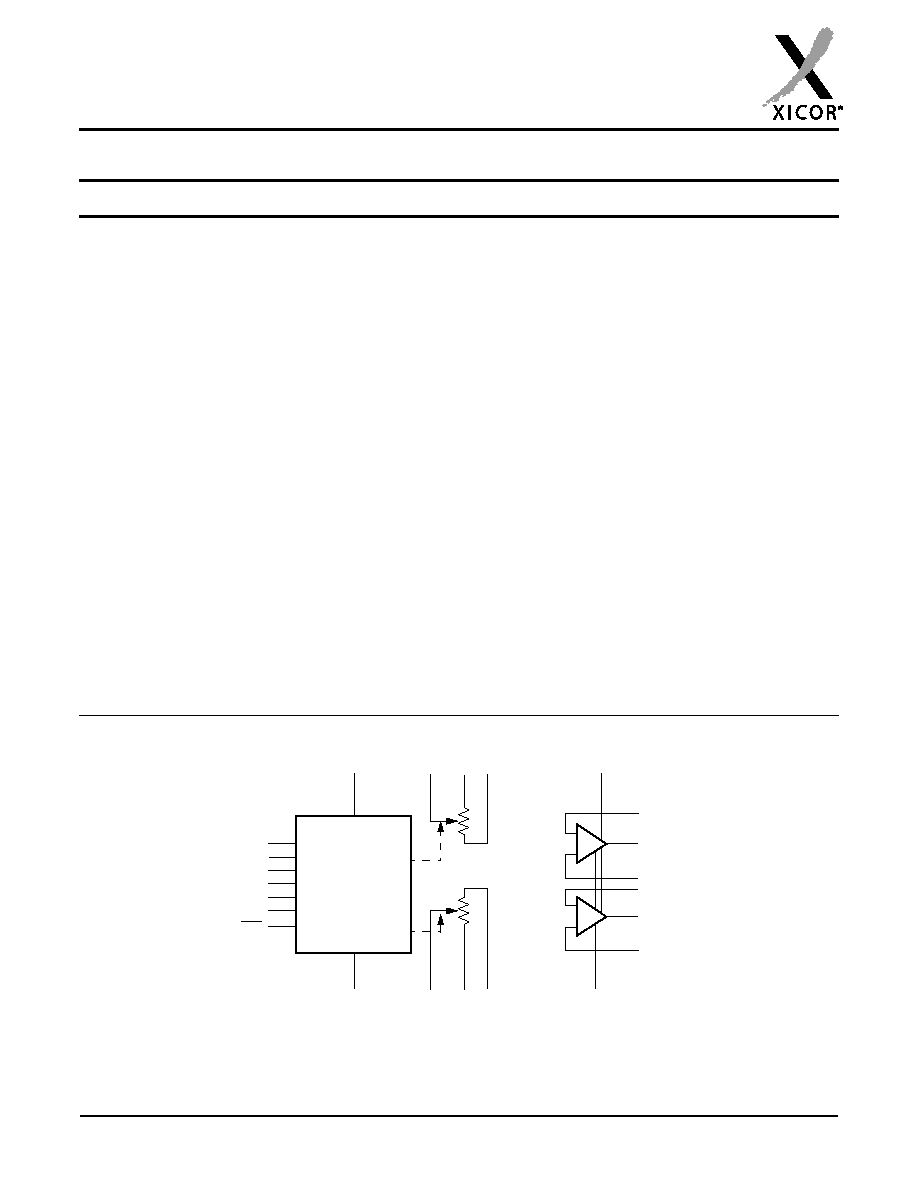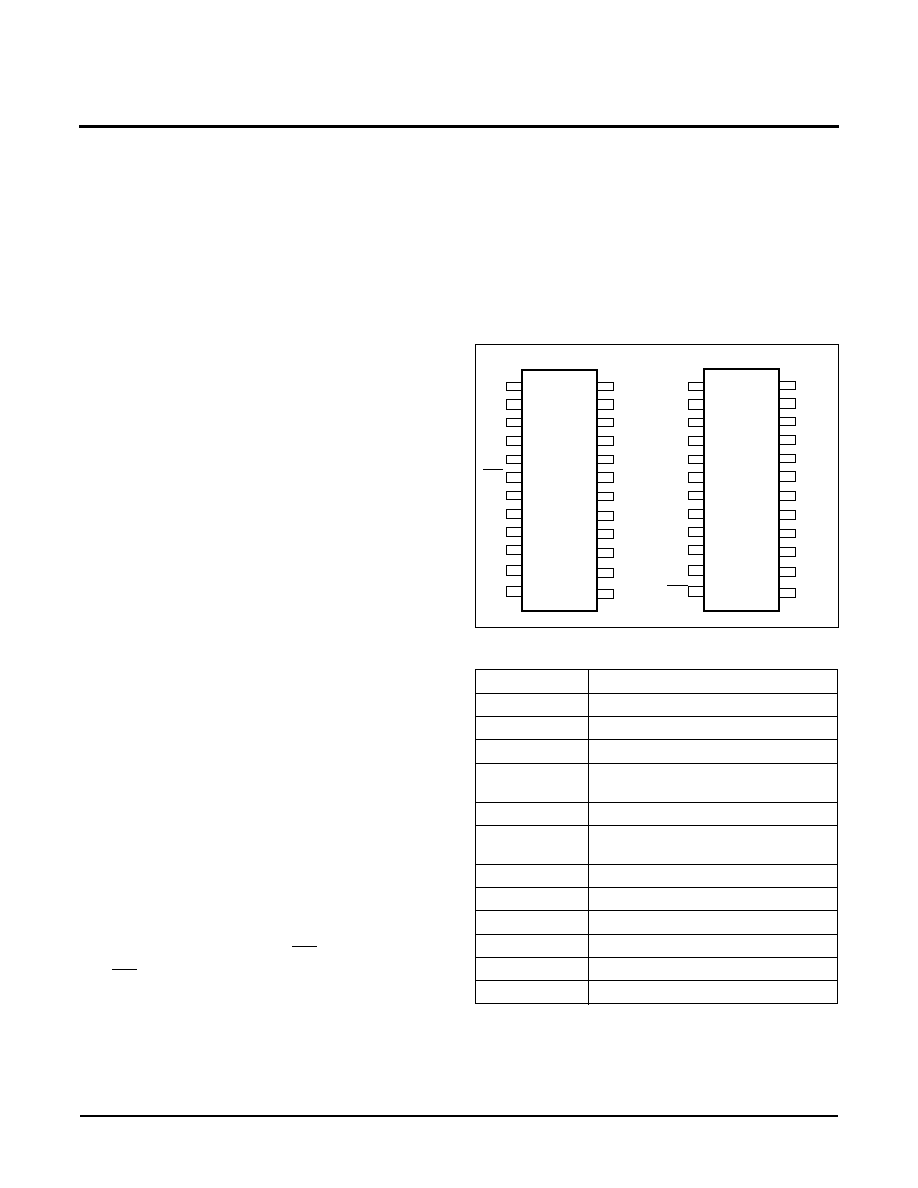 | ÐлекÑÑоннÑй компоненÑ: X9438W | СкаÑаÑÑ:  PDF PDF  ZIP ZIP |
X9438.fm

REV 1.0 6/21/00
Characteristics subject to change without notice.
1 of 18
www.xicor.com
Preliminary Information
Programmable Analog
X9438
Dual Digitally Controlled Potentiometer (XDCP
TM
) with Operational Amplifier
FEATURES
· Two CMOS voltage operational amplifiers
· Two digitally controlled potentiometers
· Can be combined or used separately
· Amplifiers:
--Low voltage operation
--V+/V- = ±2.7V to ±5.5V
--Rail-to-rail CMOS performance
--1MHz gain bandwidth product
· Digitally controlled potentiometers
--Dual 64 tap potentiometers
--R
total
= 10k
--2-wire serial interface
--V
CC
= 2.7V to 5.5V
DESCRIPTION
The X9438 is a monolithic CMOS IC that incorporates
two operational amplifiers and two nonvolatile digitally
controlled potentiometers. The amplifiers are CMOS
differential input voltage operational amplifiers with
near rail-to-rail outputs. All pins for the two amplifiers
are brought out of the package to allow combining
them with the potentiometers, or using them as com-
plete stand-alone amplifiers.
The digitally controlled potentiometers consist of a
series string of 63 polycrystalline resistors that behave
as standard integrated circuit resistors. The two-wire
serial port, common to both pots, allows the user to
program the connection of the wiper output to any of
the resistor nodes in the series string. The wiper posi-
tion is saved in the on board E2 memory to allow for
nonvolatile restoration of the wiper position.
A wide variety of applications can be implemented
using the potentiometers and the amplifiers. A typical
application is to implement the amplifier as a wiper
buffer in circuits that use the potentiometer as a voltage
reference. The potentiometer can also be combined
with the amplifier yielding a digitally programmable gain
amplifier or programmable current source.
BLOCK DIAGRAM
V
OUT1
Control and
SCL
SDA
A3
A2
A1
A0
+
Memory
WP
V
CC
V
NI0
V+
V
R
W0
V
SS
V
OUT0
+
V
NI1
V
INV1
V
INV0
R
H0
R
L0
R
W1
R
L1
R
H1
WCR1
WCR0

X9438 Preliminary Information
Characteristics subject to change without notice.
2 of 18
REV 1.0 6/21/00
www.xicor.com
PIN DESCRIPTIONS
Host Interface Pins
Serial Clock (SCL)
The SCL input is used to clock data into and out of the
X9438.
Serial Data (SDA)
SDA is a bidirectional pin used to transfer data into and
out of the device. It is an open drain output and may be
wire-ORed with any number of open drain or open col-
lector outputs. An open drain output requires the use of
a pull-up resistor.
Device Address (A
0
A
3
)
The address inputs are used to set the least significant
4 bits of the 8-bit slave address. A match in the slave
address serial data stream must be made with the
address input in order to initiate communication with
the X9438. A maximum of 16 devices may share the
same 2-wire serial bus.
Potentiometer Pins
(1)
R
H
(R
H0
R
H1
), R
L
(R
L0
R
L1
)
The R
H
and R
L
inputs are equivalent to the terminal
connections on either end of a mechanical potentiometer.
R
W
(R
W0
R
W1
)
The wiper output is equivalent to the wiper output of a
mechanical potentiometer.
Amplifier and Device Pins
Amplifier Input Voltage V
NI
(0,1) and V
INV
(0,1)
V
NI
and V
INV
are inputs to the noninverting (+) and
inverting (-) inputs of the operational amplifiers.
Amplifier Output Voltage V
OUT
(0,1)
V
OUT
is the voltage output pin of the operational amplifier.
Hardware Write Protect Input WP
The WP pin, when low, prevents non-volatile writes to
the wiper counter registers.
Note:
(1) Alternate designations for R
H
, R
L
, R
W
are V
H
, V
L
, V
W
Analog Supplies V+, V-
The analog supplies V+, V- are the supply voltages for
the XDCP analog section and the operational amplifiers.
System Supply V
CC
and Ground V
SS
.
The system supply V
CC
and its reference V
SS
is used
to bias the interface and control circuits.
PIN CONFIGURATION
PIN NAMES
Symbol
Description
SCL
Serial Clock
SDA
Serial Data
A0-A3
Device Address
R
H0
R
H1
,
R
L0
R
L1
Potentiometers (terminal equivalent)
R
W0
R
W1
Potentiometers (wiper equivalent)
V
NI(0,1)
,
V
INV(0,1)
Amplifier Input Voltages
V
OUT0,
V
OUT1
Amplifier Outputs
WP
Hardware Write Protection
V+,V-
Analog and Voltage Amplifier Supplies
V
CC
System/Digital Supply Voltage
V
SS
System Ground
NC
No Connection
V
CC
R
L0
R
H0
WP
SDA
A1
1
2
3
4
5
6
7
8
9
10
24
23
22
21
20
19
18
17
16
15
V+
V
OUT0
V
NI0
V
INV0
A0
NC
A
3
SCL
V
INV1
V
NI1
SOIC
X9438
V
SS
R
W0
14
13
11
12
A
2
R
L1
R
H1
R
W1
V
OUT1
V-
V-
V
INV0
V
NI0
A
3
NC
SCL
1
2
3
4
5
6
7
8
9
10
24
23
22
21
20
19
18
17
16
15
WR
A
2
V
CC
R
W0
TSSOP
X9438
V+
V
OUT0
14
13
11
12
A
0
V
OUT1
V
NI1
V
INV1
R
L0
R
H0
V
SS
R
W1
R
H1
R
L1
A
1
SDA

X9438
Preliminary Information
Characteristics subject to change without notice.
3 of 18
REV 1.0 6/21/00
www.xicor.com
PRINCIPLES OF OPERATION
The X9438 is an integrated microcircuit incorporating
two resistor arrays, two operational amplifiers and their
associated registers and counters; and the serial inter-
face logic providing direct communication between the
host and the digitally controlled potentiometers and
operational amplifiers.
Serial Interface
The X9438 supports a bidirectional bus oriented proto-
col. The protocol defines any device that sends data
onto the bus as a transmitter and the receiving device
as the receiver. The device controlling the transfer is a
master and the device being controlled is the slave.
The master will always initiate data transfers and pro-
vide the clock for both transmit and receive operations.
Therefore, the X9438 will be considered a slave device
in all applications.
Clock and Data Conventions
Data states on the SDA line can change only during
SCL LOW periods (t
LOW
). SDA state changes during
SCL HIGH are reserved for indicating start and stop
conditions.
Start Condition
All commands to the X9438 are preceded by the start
condition, which is a HIGH to LOW transition of SDA
while SCL is HIGH (t
HIGH
). The X9438 continuously
monitors the SDA and SCL lines for the start condition
and will not respond to any command until this condi-
tion is met.
Stop Condition
All communications must be terminated by a stop con-
dition, which is a LOW to HIGH transition of SDA while
SCL is HIGH.
Acknowledge
Acknowledge is a software convention used to provide
a positive handshake between the master and slave
devices on the bus to indicate the successful receipt of
data. The transmitting device, either the master or the
slave, will release the SDA bus after transmitting eight
bits. The master generates a ninth clock cycle and dur-
ing this period the receiver pulls the SDA line LOW to
acknowledge that it successfully received the eight bits of
data.
The X9438 will respond with an acknowledge after rec-
ognition of a start condition and its slave address and
once again after successful receipt of the command
byte. If the command is followed by a data byte the
X9438 will respond with a final acknowledge.
Operational Amplifier
The voltage operational amplifiers are CMOS rail-to-
rail output general purpose amplifiers. They are
designed to operate from dual (±) power supplies. The
amplifiers may be configured like any standard ampli-
fier. All pins are externally available to allow connec-
tions with the potentiometers or as stand alone
amplifiers.
Potentiometer/Array Description
The X9438 is comprised of two resistor arrays and two
operational amplifiers. Each array contains 63 discrete
resistive segments that are connected in series. The
physical ends of each array are equivalent to the fixed
terminals of a mechanical potentiometer (R
H
and R
L
inputs).
At both ends of each array and between each resistor
segment is a CMOS switch connected to the wiper
(R
W
) output. Within each individual array only one
switch may be turned on at a time. These switches are
controlled by a volatile wiper counter register (WCR).
The six bits of the WCR are decoded to select, and
enable, one of sixty-four switches.
The WCR may be written directly, or it can be changed
by transferring the contents of one of four associated
data registers into the WCR. These data registers and
the WCR can be read and written by the host system.
INSTRUCTIONS AND PROGRAMMING
Device Addressing
Following a start condition the master must output the
address of the slave it is accessing. The most signifi-
cant four bits of the slave address are the device type
identifier (refer to Figure 1). For the X9438 this is fixed
as 0101[B].
Figure 1. Address/Identification Byte Format
1
0
0
A3
A2
A1
A0
Device Type
Identifier
Device Address
1

X9438 Preliminary Information
Characteristics subject to change without notice.
4 of 18
REV 1.0 6/21/00
www.xicor.com
The next four bits of the slave address are the device
address. The physical device address is defined by the
state of the A
0
A
3
inputs. The X9438 compares the
serial data stream with the address input state; a suc-
cessful compare of all four address bits is required for
the X9438 to respond with an acknowledge. The A
0
A
3
inputs can be actively driven by CMOS input signals
or tied to V
CC
or V
SS
.
Acknowledge Polling
The disabling of the inputs, during the internal non-vol-
atile write operation, can be used to take advantage of
the typical 5ms EEPROM write cycle time. Once the
stop condition is issued to indicate the end of the non-
volatile write command the X9438 initiates the internal
write cycle. ACK polling (Flow 1) can be initiated imme-
diately. This involves issuing the start condition fol-
lowed by the device slave address. If the X9438 is still
busy with the write operation no ACK will be returned.
If the X9438 has completed the write operation an ACK
will be returned and the master can then proceed with
the next operation.
Flow 1. ACK Polling Sequence
Instruction Structure
The byte following the address contains the instruction
and register pointer information. The four most signifi-
cant bits are the instruction. The next four bits point to
one of the two pots and when applicable they point to
one of the four WCRs associated data registers. The
format is shown below in Figure 2.
Figure 2. Instruction Byte Format
The four high order bits define the instruction. The next
two bits (R1 and R0) select one of the two registers
that is to be acted upon when a register oriented
instruction is issued. The last bit (P0) selects which
one of the two potentiometers is to be affected by the
instruction.
Four of the nine instructions end with the transmission
of the instruction byte. The basic sequence is illus-
trated in Figure 3. These two-byte instructions
exchange data between the wiper counter register and
one of the data registers. A transfer from a data regis-
ter to a wiper counter register is essentially a write to a
static RAM. The response of the wiper to this action will
be delayed t
WRL
. A transfer from the wiper counter reg-
ister (current wiper position) to a data register is a write
to non-volatile memory and takes a minimum of t
WR
to
complete. The transfer can occur between one of the
two potentiometers and one of its associated registers;
or it may occur globally, wherein the transfer occurs
between all of the potentiometers and one of their
associated registers.
Four instructions require a three-byte sequence to
complete. The basic sequence is illustrated in Figure 4.
These instructions transfer data between the host and
the X9438; either between the host and one of the data
registers or directly between the host and the wiper
counter and analog control registers. These instruc-
tions are: 1) Read Wiper Counter Register or read the
current wiper position of the selected pot, 2) Write
Wiper Counter Register, i.e. change current wiper posi-
tion of the selected pot; 3) Read Data Register, read the
contents of the selected non-volatile register; 4) Write
Data Register, write a new value to the selected data
register. The bit structures of the instructions are shown
in Figure 6.
Nonvolatile Write
Command Completed
Enter Ack Polling
Issue
START
Issue Slave
Address
ACK
Returned?
Further
Operation?
Issue
Instruction
Issue STOP
No
Yes
Yes
Prooceed
Issue STOP
No
Prooceed
I1
I2
I3
I0
R1
R0
0
P0
WCR Select
Register
Select
Instructions

X9438
Preliminary Information
Characteristics subject to change without notice.
5 of 18
REV 1.0 6/21/00
www.xicor.com
Figure 3. Two-Byte Command Sequence
Figure 4. Three-Byte Command Sequence
S
T
A
R
T
0
1
0
1
A3
A2
A1
A0
A
C
K
I3
I2
I1
I0
R1
R0
0
P0
A
C
K
SCL
SDA
S
T
O
P
S
T
A
R
T
0
1
0
1
A3 A2 A1 A0 A
C
K
I3
I2
I1 I0
0
P0 R1 R0 A
C
K
SCL
SDA
S
T
O
P
A
C
K
D5 D4 D3 D2
D1 D0
The Increment/Decrement command is different from
the other commands. Once the command is issued
and the X9438 has responded with an acknowledge,
the master can clock the selected wiper up and/or
down in one segment steps; thereby, providing a fine
tuning capability to the host. For each SCL clock pulse
(t
HIGH
) while SDA is HIGH, the selected wiper will
move one resistor segment towards the V
H
terminal.
Similarly, for each SCL clock pulse while SDA is LOW,
the selected wiper will move one resistor segment
towards the V
L
terminal. A detailed illustration of the
sequence for this operation is shown in Figure 5.
Figure 5. Increment/Decrement Command Sequence
S
T
A
R
T
0
1
0
1
A3 A2 A1 A0
A
C
K
I3
I2
I1
I0
P1 P0 R1 R0
A
C
K
SCL
SDA
S
T
O
P
X
X
I
N
C
1
I
N
C
2
I
N
C
n
D
E
C
1
D
E
C
n




